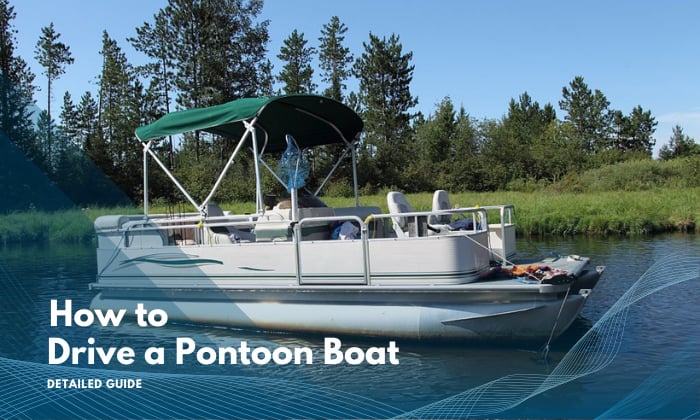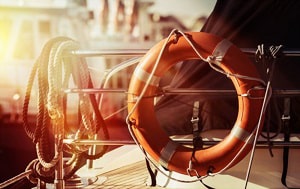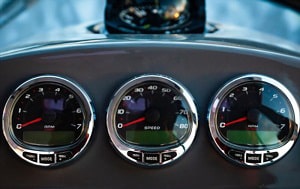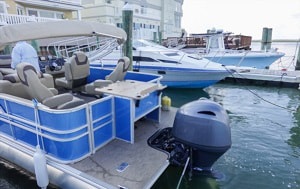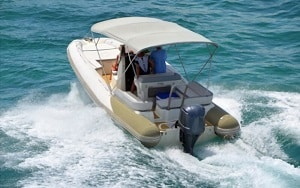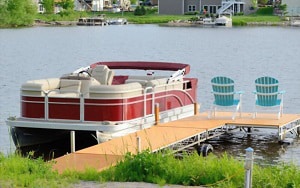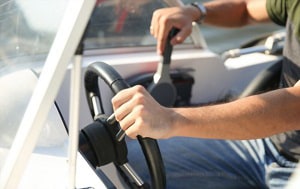Have you ever ridden a pontoon boat and thought, “Hey, maybe it’s no different from coasting with my Toyota?” Well, while driving a boat is certainly not like driving a car, it’s still arguably a skill that anyone can learn.
Learning how to drive a pontoon boat means you get to be the captain and save money on hiring one. With everything considered, it’s not at all hard to drive a pontoon boat.
This complete guide proves as much. It covers the basics of driving a boat, and walks you through every essential step, so you’ll be comfortably cruising soon.
Table of Contents
- Things to Bring Aboard
- Step-by-step to Drive a Pontoon Boat
- Step 1: Confirm everything you need to have before driving.
- Step 2: Get comfortable with the fundamentals at the helm.
- Step 3: Trim the motor down then start it.
- Step 4: Get to the plane and get the hang of accelerating and turning.
- Step 5: Learn how to dock properly.
- Step 6: Continue boating and learn more as much as possible.
- FAQs
- Conclusion
Things to Bring Aboard
- Anchor with suitable chain and rope
- Safety equipment and tools required by the US Coast Guard
- Boater’s safety certification (temporary or permanent)
Step-by-step to Drive a Pontoon Boat
Step 1: Confirm everything you need to have before driving.
This applies to all boaters, even those that aren’t technically driving a pontoon boat for the first time. Most states in the US require you to carry the certificate mentioned above, which serves as your license to drive a pontoon boat.
The anchor is a given, but do you have enough life jackets, flares, flags, audio distress signals, and fire extinguishers aboard? Make sure you and your passengers have life jackets on all throughout the trip.
If you’re renting the boat, the rental company should point you toward the compartment containing all of these safety tools. The same goes for the anchor and its rode.
Also, assuming this isn’t the first time you operate a pontoon boat and aren’t renting, make sure that the fuel tank still contains enough gas for your entire excursion.
Step 2: Get comfortable with the fundamentals at the helm.
The steering wheel’s pretty much straightforward, and you turn it where you want to go. What about the word “throttle” or “controller” that gets thrown around a lot?
Basically, the throttle lever functions like gear shifters found in cars and lets you control the boat’s direction. Most pontoon boat throttles are configured in such a way that pushing it down causes the boat to move backward and pushing it up moves it forward.
There’s a neutral gear located in the middle of the lever, which is where you need it to be prior to running the boat’s motor. Otherwise, the vessel won’t start at all.
You should also know what the gauges stand for past the throttle, such as the speedometer, tachometer, and depth finder if you’re also fishing. Explaining each one takes a bit of time, obviously.
I’ve looked for good videos that expound on them, and I can’t recommend this one more, so watch it for a first-hand look:
Step 3: Trim the motor down then start it.
Now that we have taken all the preparatory steps, it’s time to fire up the engine and get going! Before you turn that key, though, know that the motor’s prop needs to be in the water in order to help the boat accelerate.
It’s likely trimmed up, so you must let it into the water by pressing the trim switch on the throttle lever. Then, ask a companion if you have one to see if the prop is fully submerged.
The motor must no longer budge as you press the trim-down button; that’s a sign it’s positioned correctly. Afterward, ensure the boat’s in neutral and then start the motor by turning the key.
Step 4: Get to the plane and get the hang of accelerating and turning.
Make sure your passengers are safely seated before getting the motor in gear.
Depending on how your boat is docked, you may need to back it down or pull the lever forward to start going. If it’s the latter, you have to put it in reverse and start turning the wheel so that the bow is facing the open sea and not the shore.
It’s important to back it down slowly, and if you’ve driven a car in reverse before (like getting out of a parking lot space), it’s actually a lot like that.
Once your boat is ready to go forward, shift the throttle forward. Most pontoons will get up on plane pretty quickly.
- Once you hit speeds of around 28 mph, you need to trim your motor so that the boat will run smoothly and quickly and stop porpoising.
- Click on the trim up button a few times until you start feeling the bow rise up and for the boat to start driving more smoothly and accelerate more. Adjust accordingly.
- Trimming in waves can be difficult and requires the use of trim tabs most of the time. It’s important to know how to make the most of these gadgets to drive optimally. Often, people lower the tabs when the water is rough.
- Most modern pontoon boats turn sharply, like a car. However, I recommend you avoid turning too tightly (i.e. turning the steering wheel all the way), as it may cause you or your passengers to keel over and go overboard. At the same time, lower the trim during turns.
- You have to maintain a good visual of everything ahead of you and in your periphery as you’re driving, so as to avoid collisions.
Step 5: Learn how to dock properly.
To start a pontoon boat and drive it may become easy as pie before long. However, it can be quite tricky to master how to dock it, so much so that it has become a staple Reddit discussion over the years.
Most of the time, going nice and slow does the trick. If you’re just starting out, I suggest you keep the boat in neutral gear while steering to adjust how you’re going to position the vessel on the dock.
If you have family along with you, don’t hesitate to ask them to lend a helping hand. Having someone grab the dock post, wrap a rope around the cleats, or give that needed push to get going will help a lot already.
Practice Makes Perfect
Practice the “pin the dock” maneuver, assuming the local dock owner is alright with it. It should be fine most of the time, since most pontoons come with fenders designed to absorb the impact.
Basically, this maneuver involves slowly driving toward the dock by going in and out of gear. Once your pontoon’s bow touches the dock, you keep it in gear so that it will stay in place, enough for the boat to remain stable even in windy conditions and for you to unload and load passengers.
Step 6: Continue boating and learn more as much as possible.
There’s really no better teacher than experience. If you look back and think about it, what allowed you to make driving a car or riding a bike an everyday activity?
The same can be said for pontoon boat operation. Much like how it’s not really that hard to get the hang of accelerating and turning, docking (i.e. boat parking) gets easier with practice.
Moreover, familiarize yourself with the waterway(s) you frequent.
- What are the usual water and weather conditions in the ocean in your locale?
- Are there no wake zones in your area where you need to limit your speed? Where are their boundaries?
- Are you more comfortable riding on a lake? Usually, it’s easier to practice in calmer waterways, unlike out in the ocean, where you’ll likely be in rough water if the weather’s not cooperating.
- Don’t take the fun out of the equation when driving a boat.
- Assuming one’s available in your area, practice docking in local docks with not too many boats and people.
FAQs
Is it difficult to drive a pontoon boat?
As the steps above readily show, not really. Besides the obvious difference from driving land vehicles, a lot of dread that may come from driving a boat may stem from the thought of “captaining” a boat, which immediately makes us think we have “big” shoes to fill.
Thankfully, much like learning how to drive a car, once you get the hang of it, it becomes automatic. For most people, it only takes diving into the basics coupled with consistent practice to master it.
Are pontoons good for beginners?
Compared to most other motorized sea vessels, pontoons definitely deserve to be listed as the more, if not most, beginner-friendly of the bunch. Most models are designed for easy handling and navigation, especially the modern ones that turn on a dime.
You’ll without a doubt agree with this once you put the steps above into practice and begin boating by yourself regularly.
Conclusion
Now that you possess all this knowledge on how to drive a pontoon boat, I hope you take the time to apply it.
At best, the entire process can be summed up into the initial preparations such as getting all safety items and passengers in check. Afterward, with the throttle in the right position, you can start up the motor and begin driving!
I can’t stress this enough: you actually have to get out there and start boating! Most of the steps can become routine in time – even docking.

“My intention from the first day establishing Boating Basics Online is to provide as much help as possible for boaters who want to experience a first safe and convenient trip. So feel free to join us and share your beautiful journeys to the sea!”

